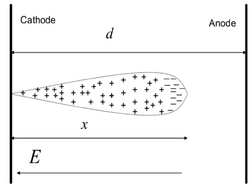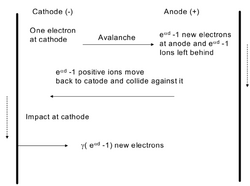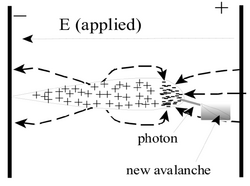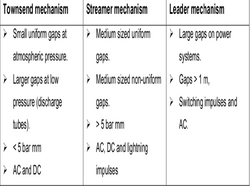Insulators under a high voltage
Introduction
Air is one of insulators that prevent charge exchange between two charged conductors. Parallel plates is an example where the air is insulating the negatively charged plate from he positively charged one. Nevertheless, air does keep this properties when the voltage difference between the plates causes air ionization. the process will produce free electrons accelerates toward the positive plate.Enough number of these electrons will make the air a conductor and sparking is observed on the plates.
Processes leads to flashover
Flashover happens when the following processes take place:
- Avalanche formation
Physically is formulated using Townsend's primary ionization coefficient () that is defined as "The number of ionizing collisions that takes place during a unit length movement of one electron" (ref.1). A relationship is built combining the number of moving electrons (n) over a distance (dx) produce new free electrons (dn) as :
Solving the equation will give the number of the free electrons produced in a distance (x) as :
- Townsend discharges
Simultaneously happens with the first process, the gas ions will bombard the cathode, it will give energy to release new electrons. Townsend's secondary coefficient () is defined as "The number of electrons released at the cathode by the impact of one ion.
The impact will produce new electrons.
Based on the previous processes flashover appears, aslo can be represented by the following:
so
Falshover :
so :
where k is constant depends on the material's Townsend's coefficients, its value ranges from 2.5 and 18.
- Raether limit
limits the number of the free electron in an avalanche to 5 X 10^8, so
where x_c is the critical avalanche length.
The empirical result was based on a study included a growing avalanche by Wilson cloud chamber during the breakdown of gaps of different length and gas pressure. "When the length of the avalanche becomes large, the negative and positive charges in the avalanche distort the field in such an extend that new avalanches form ahead of the original avalanche, eventually bridging the gap." (ref. 1).
Sparking
Because of the increase in the voltage to a point to breakdown the gap, Sparking appears clearly in the area. The following table shows the mechanisms that possible to take place:
- In Our Case
The test of the HTTHGEM foil in air and under the Ar/CO2 produces sparks, in air Streamer mechanism prevails, but in Ar/CO2 the mechanism causes sparking is going to be even Townsend's mechanisms or Streamer mechanisms depending on gas pressure surrounding the HTTHGEM foils.
References
1- Dr JP Holtzhausen, Dr WL VoslooHigh "Voltage Engineering Practice and Theory" (online drift copy)



